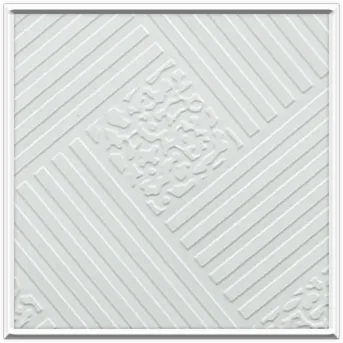Dec . 04, 2024 22:32 Back to list
what is ceiling grid made of
What is Ceiling Grid Made Of?
A ceiling grid is a framework that supports ceiling tiles or panels, allowing for modular design in both residential and commercial spaces. The ceiling grid system not only enhances aesthetic appeal but also improves acoustics, energy efficiency, and ease of access to services such as electrical, plumbing, and HVAC systems. Understanding what a ceiling grid is made of helps in making informed choices regarding installation, maintenance, and design.
Materials Used in Ceiling Grids
1. Metal The most common material for ceiling grids is metal, particularly galvanized steel or aluminum. Galvanized steel is treated to resist rust and corrosion, making it an ideal choice for areas exposed to moisture. Aluminum grids are lighter and also resistant to rust, providing a durable yet weight-efficient option. Metal grids can support heavier ceiling tiles, such as those used in high-traffic or high-impact areas.
2. PVC (Polyvinyl Chloride) Another material used in ceiling grids is PVC, which is favored in environments where moisture is prevalent, like bathrooms and kitchens. PVC is lightweight, easy to install, and non-corrosive, making it an excellent choice for areas with high humidity. It also offers aesthetic versatility as it can be manufactured in various colors and patterns.
3. Wood While less common in commercial applications, wood ceiling grids can add a unique, natural touch to residential spaces. Wooden grids can be aesthetically pleasing and are often used in restaurants, cafes, and homes where a rustic or modern design is desired. However, wood is less resistant to humidity and potential pests, hence may require treatment or special care.
4. Fiberglass Fiberglass ceiling grids can be used in specialized environments, particularly in laboratories or industrial settings where resistance to chemicals is important. Fiberglass provides a robust framework that is resistant to moisture, chemicals, and temperature changes. This makes it an excellent choice for settings requiring stringent safety and compliance criteria.
what is ceiling grid made of

5. Composite Materials In some applications, composite materials are used, combining various elements such as resin and fiberglass. These materials offer enhanced strength and durability while remaining lightweight. Composite grids can provide flexibility in design and functionality, making them suitable for a variety of architectural styles.
Benefits of Different Ceiling Grid Materials
Choosing the right material for a ceiling grid depends on many factors, including application, environment, aesthetics, and budget. Metal grids are often preferred for commercial applications due to their strength and durability, while PVC and fiberglass offer moisture resistance for specific environments. Wood, on the other hand, brings warmth and style to interiors but may require additional care.
Consideration should also be given to installation and maintenance. Metal grids can typically be reused if they are undamaged during removal, while other materials, such as PVC, may need to be replaced over time. Appearance is another critical factor; the choice of material can influence not only the look of the ceiling but also its acoustic properties.
Conclusion
In conclusion, the materials that make up ceiling grids include metal, PVC, wood, fiberglass, and composite options. Each material presents its own set of advantages and considerations for installation, maintenance, and aesthetic design. When planning a construction or renovation project, understanding these materials can help achieve the desired outcome, enhancing both the functionality and visual appeal of the space. Whether in a cozy home or a bustling commercial space, the right ceiling grid material can make a significant difference.
-
Quality Ceiling Trap Doors & Access Panels | Easy & Secure AccessNewsAug.30,2025
-
Durable Ceiling T Grid Systems | Easy InstallationNewsAug.29,2025
-
PVC Gypsum Ceiling: Durable, Laminated Tiles for Modern SpacesNewsAug.28,2025
-
Pvc Gypsum Ceiling Is DurableNewsAug.21,2025
-
Mineral Fiber Board Is DurableNewsAug.21,2025
-
Ceiling Tile Clip Reusable DesignNewsAug.21,2025







